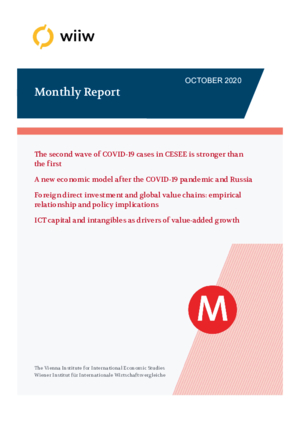Monthly Report No. 10/2020
Amat Adarov, Ruslan Grinberg, Julia Grübler and Robert Stehrer
wiiw Monthly Report No. 10, October2020
50 pages including 3 Tables and 29 Figures
- Chart of the month: The second wave of COVID-19 cases in CESEE is stronger than the first
by Julia Grübler
- Opinion Corner: A new economic model after the COVID-19 pandemic and Russia
by Ruslan Grinberg
The COVID-19 pandemic is likely to accelerate the search for a new economic model, which will become more socially oriented. However, Russia is not participating in this search. It is torn between the two extreme schools of economic thought: market liberals and proponents of a return to Soviet-style planning, with very little in between.
- Foreign direct investment and global value chains: empirical relationship and policy implications
by Amat Adarov and Robert Stehrer
Global value chain integration is strongly related to foreign direct investment flows, which might be hampered by regulatory restrictions. These, however, might be justified from a national or EU-wide security and resilience perspective.
- ICT capital and intangibles as drivers of value-added growth
by Amat Adarov and Robert Stehrer
ICT capital and intangible capital have been significant drivers of economic growth in the last two decades, though they have lost some steam since the global financial crisis. For EU-CEE, however, there is still a potential to exploit these drivers of growth.
- Monthly and quarterly statistics for Central, East and Southeast Europe
Reference to wiiw databases: wiiw Annual Database, wiiw Monthly Database
Keywords: COVID-19, new economic model, role of the government, foreign direct investment, global value chains, barriers to FDI, ICT capital, intangible capital, growth accounting
Countries covered: CESEE, European Union, Japan, non specific, OECD, Russia, US
Research Areas: Macroeconomic Analysis and Policy, International Trade, Competitiveness and FDI, Sectoral studies
